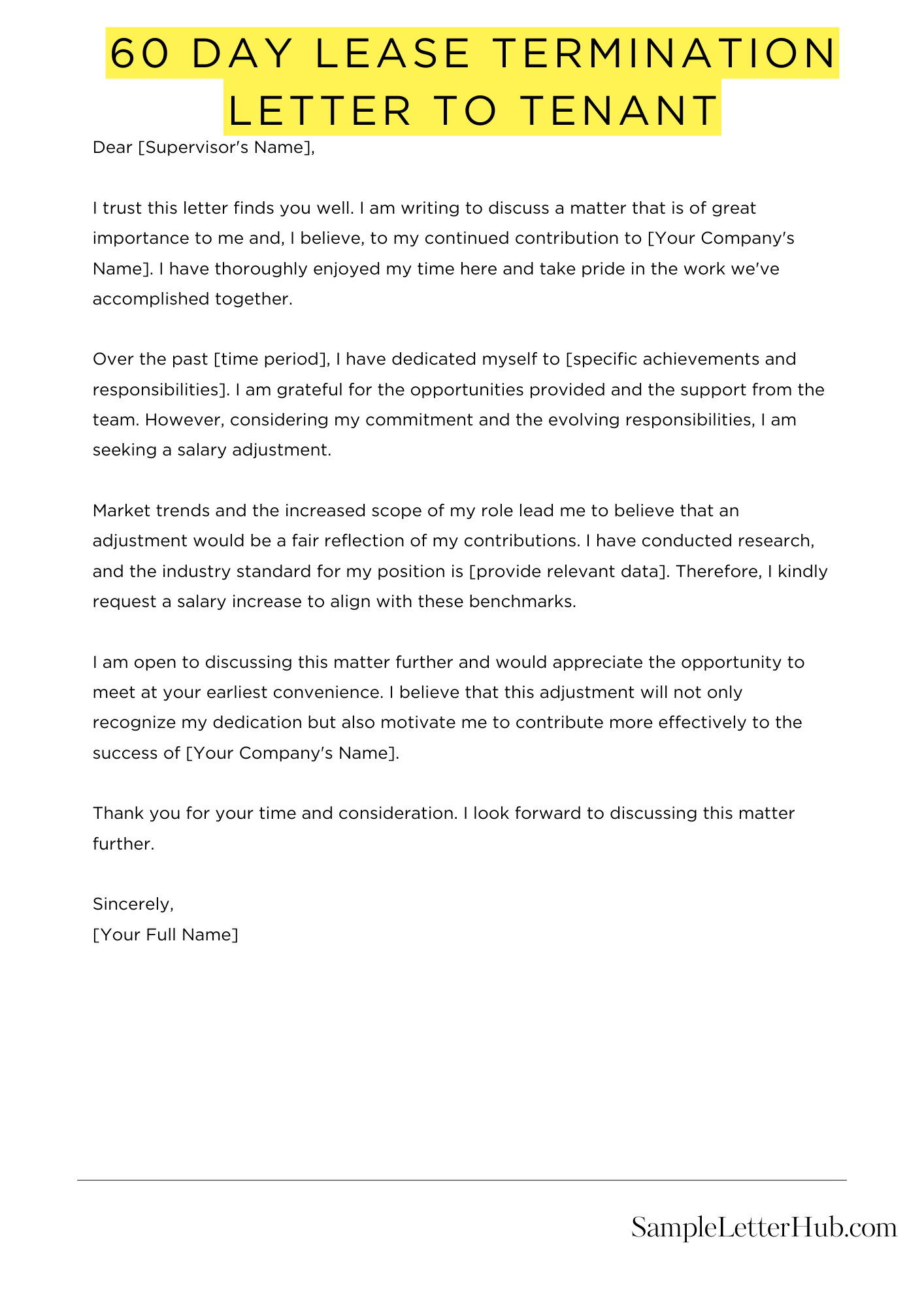A 60 Day Termination Letter To A tenant is a legal document that is used to inform a tenant that their tenancy is being terminated. This letter must be given to the tenant at least 60 days before the end of their lease. The letter should include the reason for the termination, the date the tenancy will end, and any other relevant information.
In this article, we will provide you with some templates/examples/samples of 60 Day Termination Letter To A tenant. These templates will help you to easily draft a letter that meets your specific needs.
60 Day Lease Termination Notice to Tenant
Dear [Tenant Name],
Please accept this notice as formal notification that your lease agreement for the property located at [Property Address] will be terminated in 60 days, effective [Date].
This termination is in accordance with the terms of your lease agreement, which states that either party may terminate the lease with 60 days’ written notice.
During the remaining 60 days of your tenancy, please ensure that you:
* Pay all outstanding rent and utilities.
* Maintain the property in good condition.
* Remove all personal belongings from the property.
* Return all keys to the landlord.
Please contact me if you have any questions or require any assistance during the move-out process.
Sincerely,
[Your Name]

How to Write a 60 Day Lease Termination Letter to Tenant
1. Start with a Formal Introduction
Begin your letter with a formal introduction that includes the tenant’s name, address, and the date of the letter. For example, you could write:
Dear [Tenant’s Name],
[Tenant’s Address]
[Date]
2. State the Purpose of the Letter
In the first paragraph of the letter, clearly state that you are terminating the tenant’s lease. Be sure to include the date the lease will terminate. For example, you could write:
I am writing to inform you that I am terminating your lease for the property located at [property address]. Your lease will terminate on [termination date].
3. Explain the Reason for Termination (Optional)
While it is not always necessary to provide a reason for terminating a lease, you may choose to do so in your letter. If you are terminating the lease for a specific reason, such as a violation of the lease agreement, you should state this clearly in the letter. For example, you could write:
I am terminating your lease due to your repeated violations of the lease agreement, including your failure to pay rent on time and your unauthorized subletting of the property.
4. Provide Notice of the Tenant’s Responsibilities
In the letter, you should also remind the tenant of their responsibilities upon termination of the lease. This may include cleaning the property, returning keys, and paying any outstanding rent or fees. For example, you could write:
Upon termination of the lease, you are responsible for cleaning the property, returning all keys, and paying any outstanding rent or fees.
5. Offer to Assist with the Move-Out Process
If you are willing to assist the tenant with the move-out process, you can offer to do so in the letter. This may include helping the tenant find a new place to live or providing them with moving supplies. For example, you could write:
I am willing to assist you with the move-out process in any way that I can. Please let me know if you need any help finding a new place to live or if you need any moving supplies.
6. Close the Letter
End the letter with a polite closing, such as:
Thank you for your understanding.
Sincerely,
[Your Name]
7. Proofread the Letter
Before sending the letter, be sure to proofread it carefully for any errors in grammar or spelling. You should also make sure that all of the information in the letter is accurate and up-to-date.
FAQs about 60 Day Lease Termination Letter To Tenant
What is a 60-day lease termination letter?
A 60-day lease termination letter is a formal notice from a landlord to a tenant, informing them that their lease will be terminated in 60 days. This type of letter is typically used when the landlord does not wish to renew the lease or when the tenant has violated the terms of the lease.
What are the grounds for terminating a lease?
The grounds for terminating a lease can vary depending on the specific terms of the lease and the applicable laws in the jurisdiction where the property is located. However, some common grounds for lease termination include:
- Non-payment of rent
- Violation of the lease terms
- Damage to the property
- Illegal activity on the property
What should be included in a 60-day lease termination letter?
A 60-day lease termination letter should include the following information:
- The date of the letter
- The name and address of the tenant
- The address of the property
- The date the lease will be terminated
- The reason for the lease termination
- Any other relevant information, such as instructions for vacating the property
How should a 60-day lease termination letter be served?
A 60-day lease termination letter can be served in person, by mail, or by email. If the letter is served by mail, it should be sent certified mail, return receipt requested.
What are the consequences of not responding to a 60-day lease termination letter?
If a tenant does not respond to a 60-day lease termination letter, the landlord may proceed with the eviction process. This can result in the tenant being removed from the property and owing the landlord back rent and other damages.

